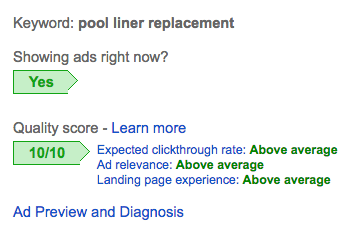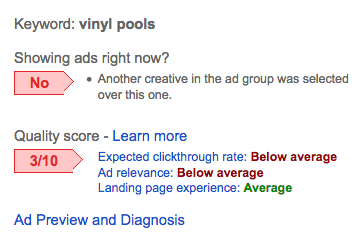
It’s easy to start thinking of Google Adwords like it’s a big ‘ole slot machine.
You write your ads, start a campaign and then keep putting money in, hoping that one day you’ll hit the jackpot – with success coming as a combination of persistence and a healthy dose of luck.
Fortunately, there’s a lot more to digital marketing than crossing your fingers and pulling out your credit card.
Setting up a campaign for success
A well-built and optimized digital marketing campaign will be based carefully researched keywords and interesting, well-written ad copy. But after you turn everything on, it can feel like you’re just leaving everything up to chance. How do you know what needs to be improved? How can you get the best results?
Fortunately, there’s a metric in Google Adwords that literally tells you how well your campaign is targeting for each of your keywords. Seriously.
Google uses this metric to adjust your bid prices – meaning the better and more relevant your ad is to the search query, the less you’ll have to pay to earn the top spot.
I believe the official marketing expression for grabbing first place while paying less is “Booyah!”
*ahem*
This metric is called “Quality Score”, and this post is going to show you where you can find it and how to improve it.
What’s the value of a good Quality Score?
Keywords in your campaign get a Quality Score ranking out of 10 based on a number of factors, and this is taken into consideration every time the ads compete against one another for placing on the search results page.
Now, here’s the kicker – a high-quality score earns you discounts on your cost per click, while a quality score will require you to dish out a lot more.
How much more? Well, that’s not so easy to pin down, but various sources suggest a 10 out of 10 can earn you a 30% discount, while a 1 out of 10 could have you dropping 300% of your original bid if your ad gets the click.
In other words, focusing on constantly improving your Quality Score should be a no-brainer.
Where do I find my Quality Score Ratings?
Login into your Adwords campaign, click the “Keywords” tab from the top menu, then click the “Columns” drop-down menu and select “Modify columns…”
From the left-hand options select “Quality score” and click the right-pointing arrow beside “Qual. score”. Make sure to click the blue “Apply” button at the bottom to save these changes.
You can now sort your keywords to get a quick understanding of which keywords are performing well … and which ones aren’t.
For a more detailed breakdown of the factors attributing to the Quality Score, you can hover your mouse over the icon in the “Status” column beside each keyword.
This brings up a window that looks like this when your keyword is on the money:

Or like this, when your keyword is underperforming:

Let’s take a closer look at each factor…
1. Ad Relevance
Making sure your ads are actually relevant to what your visitors are searching for is probably the quickest way to improve your Quality Score rankings.
It can be tempting to throw a million keywords into Adwords with the goal of ranking first on the top of every search. But that approach is more likely than not going to frustrate users who search for one thing and get shown ads that deal with another.
Hyper-specific campaigns, perhaps with only one keyword per Ad Group, are a trend in digital marketing. This keeps your ads relevant, and your clickthrough rates and Quality Scores high.
2. Expected Clickthrough Rate
For this metric, Google will take a look at your historical clickthrough data to determine whether or not your ads are resonating with searchers.
This is a way to determine how appealing and relevant your ads are; if your ads are showing but people aren’t clicking, it’s fair to assume that your ads probably aren’t very good.
So rather than continue to muddle up the results with results that have been proven to be crap, Google knocks some numbers off your Quality Score, meaning you’re either going to have to adjust or get used to paying a bit more per click.
3. Landing Page Experience
This one might even catch some digital marketers by surprise. If your Adwords campaign is underperforming, the problem might be with your landing pages
But it makes perfect sense since misdirecting visitors or simply leading them down the path to an irrelevant landing page is worth a couple notches off of your Quality Score.
Keeping your keywords, ad copy and landing page content in alignment guarantees a smooth experience for anyone who clicks.
Part of a Well-Built Campaign
Ultimately, your goal with digital marketing is to produce highly relevant, highly engaging ads.
Keeping a close tab on your Quality Score ratings and making adjustments here and there can be the deciding factor that lands you a jackpot of online clients.
